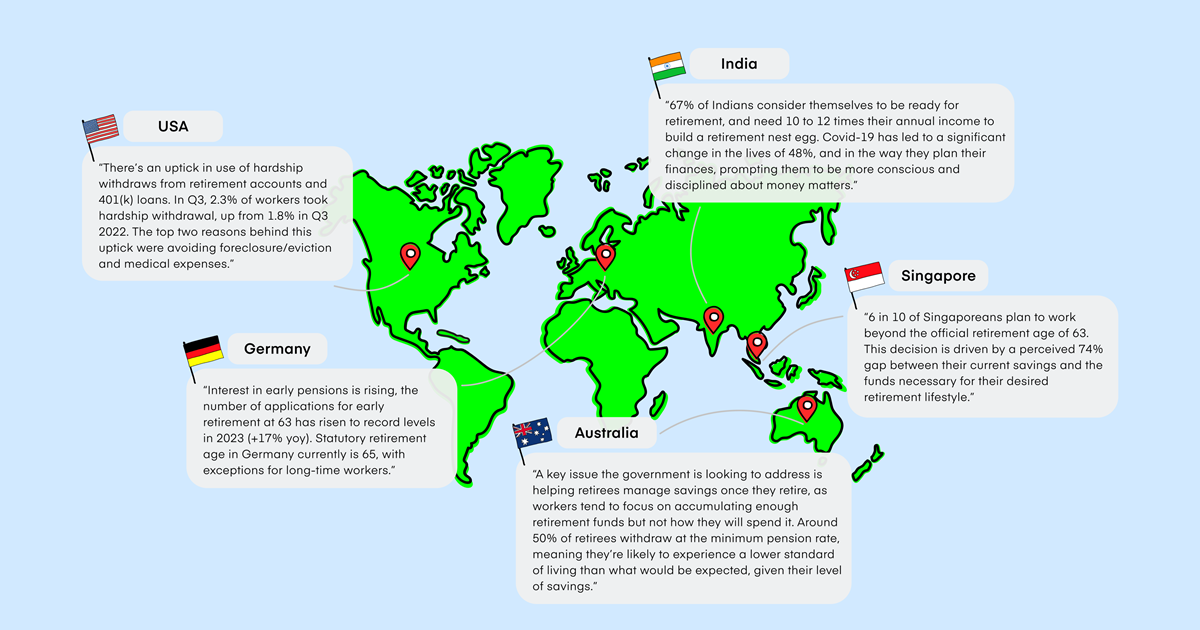Simplify retirement communications for everyone, everywhere
3 min read

Do you know how your people feel about their financial future? Are they on track for a financially comfortable life after work? Have you asked them recently how they are feeling about their financial future? According to a recent report from the World Economic Forum, 55% of people have not saved enough for retirement, or said ‘they’re not sure if they have.’ Being behind is one thing but being unsure of where they’re at, and not having a retirement plan at all is a much bigger issue.
If we take retirement in the US as a case study. Last year in the US, there were 163 million active 401(k) participants, and since the workforce is 290.6 million people, that means only 56% are actively participating in a 401(k).
In contrast to this shortfall in retirement planning, our recent 2024 Global financial wellbeing research reveals that 87% of employees across the globe (86% in US) say that saving for retirement is a life goal. It seems people know they need to save, and want to, but they’re struggling to prioritize it in their day-to-day.
Why are people not planning for retirement?
No instant gratification
Let’s face it, we live in a world of instant gratification. And retirement is far from instant. Planning spans decades and in that time, life changes, income or spending changes, your or your family’s health might change. Thinking further ahead than next week is challenging for all of us, in fact there are several biases that stop us from planning for the future. Present bias (hyperbolic discounting) means our brains are wired up for immediate rewards over larger, delayed rewards. Coupled with procrastination, means we must work hard to overcome our psychological limitations to plan for our financial future.
Volatile, ever-changing conditions
Retirement planning is akin to predicting the future. And how can we when the financial world changes from week to week, factors like inflation rates, investment returns, tax laws, government programs, and retirement regulations. Keeping up with market fluctuations and understanding their implications on your financial future requires continuous effort.
Off-putting terminology
With a plethora of retirement savings and account options out there, people struggle to differentiate between each. For example, you have annuities, stocks, and bonds and each investment type has its own set of rules, tax implications, and potential risks. The language, terminology and at times jargon, make it difficult for employees, particularly for those without access to financial education, to understand the nuance of different retirement products.
So, retirement planning isn’t easy, but it could be with relevant and personalized guidance at the right times in life. This is where you, as the employer, are in a unique position to play an essential role in this process. Retirement is inevitable and it’s pivotal that employers encourage their people to create a plan for life after work.
But what can employers do to step-up and simplify the experience? To help, we've collated some some global retirement insights to kick start your research.


With those retirement trends in mind, here are our tried and tested tips for workplace education to increase understanding and action:
- Start with unbiased, relevant benefit and financial education: to empower employees to make informed decisions about their retirement planning and help them understand their options or make choices that are in their best interest.
- Remove jargon and then some: simplify language, provide clear definitions, showcase examples of employees, break down complex concepts, use storytelling and interactive content, avoid industry jargon at all costs and test it out.
- Diverse language and imagery: ensures inclusivity and will enable you to connect with a diverse, global audience. Using different languages and imagery reflects diverse backgrounds, experiences, and perspectives of individuals instantly making the communications more relatable and accessible.
- Test different channels and experiences: define your different employee groups, then utilize channels such as workplace tools (slack, workplace), emails, workshops, or ERGs. Implement various communication styles, formats, and engagement strategies. Collect feedback, and engagement data then determine which channels and approaches resonate most effectively with each group.
- More impact - less comms: Cut through the retirement noise with simple, creative, and insight-driven campaigns. Employees are faced with a lot of communications on many different channels so for people to take notice, you’ll need to get creative.
- Be accessible with no barriers to entry: The key to successful communications that drive action, is providing an easy and accessible route to entry. Provide quick access to websites and information, support employees signing into their accounts for the first time and ensure all steps and additional information are clearly stated and shared centrally.
Want more insights to support your retirement strategy? Download our 2024 Global financial wellbeing report, and open a world of opportunity for your people today.
Did you know it’s National 401k day on September 6? Why not take the opportunity to launch your next big impact campaign on that day and rejuvenate retirement planning for your people this year? Want to know more global awareness dates? Download our 2024 Global Financial Wellbeing Calendar.